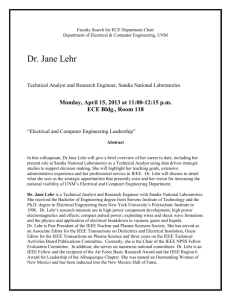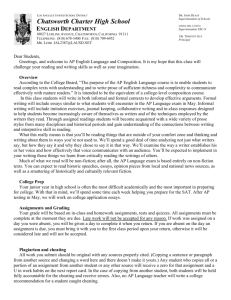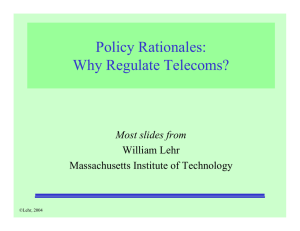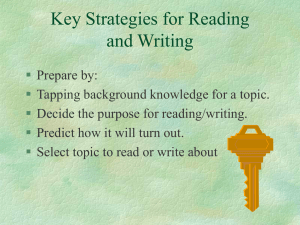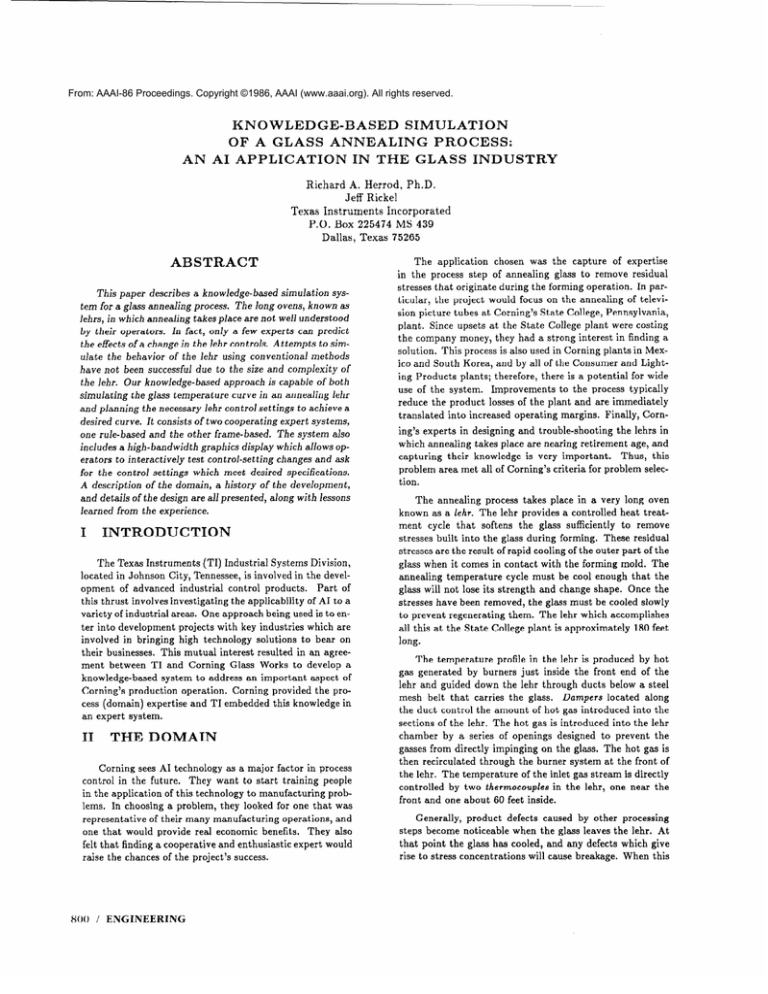
From: AAAI-86 Proceedings. Copyright ©1986, AAAI (www.aaai.org). All rights reserved.
KNOWLEDGE-BASED
SIMULATION
OF A GLASS ANNEALING
PROCESS:
AI APPLICATION
IN THE GLASS INDUSTRY
AN
Richard
A. Herrod,
Jeff
Texas
Instruments
P.O.
Box
Dallas,
ABSTRACT
This paper describes a knowledge-based
simulation
sys-
have not been successful due to the size and complexity of
the lehr. Our knowledge-based approach is capable of both
and planning
the necessary
curve in an annealing
lehr control settings
desired curve. It consists of two cooperating
lehr
to achieve a
expert systems,
one rule-based and the other frame-based.
The system also
includes a high-bandwidth graphics display which allows operators to interactively
test control-setting
changes and ask
for the control settings which meet desired specifications.
A description of the domain, a history of the development,
and details of the design are all presented, along with lessons
learned from the experience.
I
Texas
Incorporated
MS 439
75265
The
the effects of a change in the lehr controls. Attempts to simulate the behavior of the lehr using conventional methods
the glass temperature
225474
application
in the process
tem for a glass annealing process. The long ovens, known as
lehrs, in which annealing takes place are not well understood
In fact, only a few experts can predict
by their operators.
simulating
Ph.D.
Rickel
chosen
was the capture
step of annealing
of expertise
glass to remove
residual
stresses that originate during the forming operation. In particular, the project would focus on the annealing of television picture
tubes at Corning’s
State College, Pennsylvania,
plant. Since upsets at the State College plant were costing
the company money, they had a strong interest in finding a
solution.
This process is also used in Corning plants in Mex-
ico and South Korea, and by all of the Consumer and Lighting Products plants; therefore, there is a potential for wide
use of the system.
reduce the product
translated
Improvements
into increased
ing’s experts
to the process
typically
losses of the plant and are immediately
in designing
operating
margins.
Finally,
and trouble-shooting
Corn-
the lehrs in
which annealing takes place are nearing retirement age, and
capturing their knowledge is very important.
Thus, this
problem area met all of Corning’s criteria for problem selection.
The annealing process takes place in a very long oven
known as a lehr. The lehr provides a controlled heat treatment cycle that softens the glass sufficiently to remove
stresses built into the glass during forming. These residual
INTRODUCTION
stresses are the result of rapid cooling of the outer part of the
The Texas Instruments
(TI) Industrial
Systems
Division,
located in Johnson City, Tennessee, is involved in the development of advanced industrial control products.
Part of
this thrust involves investigating the applicability of AI to a
variety of industrial areas. One approach being used is to enter into development
projects
with key industries
which are
involved in bringing high technology solutions to bear on
their businesses. This mutual interest resulted in an agreement between TI and Corning Glass Works to develop a
knowledge-based system to address an important aspect of
Corning’s production operation. Corning provided the process (domain) expertise
an expert system.
II
and TI embedded this knowledge in
THE DOMAIN
glass when it comes in contact with the forming mold. The
annealing temperature
cycle must be cool enough that the
glass will not lose its strength
stresses
and change shape.
Once the
have been removed, the glass must be cooled slowly
to prevent regenerating them. The lehr which accomplishes
all this at the State College plant is approximately
180 feet
long.
The temperature
profile in the lehr is produced by hot
gas generated by burners just inside the front end of the
lehr and guided down the lehr through
ducts below a steel
mesh belt that carries the glass.
Dampers located along
the duct control the amount of hot gas introduced into the
sections of the lehr. The hot gas is introduced into the lehr
chamber
by a series
gasses from directly
then recirculated
of openings
impinging
through
designed
on the glass.
to prevent
the
The hot gas is
the burner system at the front of
Corning sees AI technology as a major factor in process
control in the future.
They want to start training people
in the application of this technology to manufacturing problems. In choosing a problem, they looked for one that was
the lehr. The temperature of the inlet gas stream is directly
controlled by two thermocouples in the lehr, one near the
front and one about 60 feet inside.
representative
of their many manufacturing
operations, and
one that would provide real economic benefits.
They also
Generally,
steps become
felt that finding a cooperative and enthusiastic
raise the chances of the project’s success.
that point the glass has cooled, and any defects which give
rise to stress concentrations
will cause breakage. When this
800
/ ENGINEERING
expert would
product defects caused by other processing
noticeable when the glass leaves the lehr. At
happens,
an expert
i:3 usually
called
in to determine
the
cause of the problem.
If he determines that the lehr is at
fault, he makes adjustments to the firing and airflow systems
until the annealing process is back 5n tune”. The expert is
also frequently needed when a change in product characteristics necessitates adjustments to the lehr, or when the lehr
is restarted
after a period of inactivity.
couples can be set just like a household thermostat;
if the
temperature
at the probe drops below the set temperature,
the temperature
of the gas produced by the burners is increased until the temperature
reaches the desired setting
again. Dampers throughout the lehr control where the hot
air is directed. By opening all the dampers, the heat is distributed fairly evenly through the lehr. By closing a certain
damper, heat is blocked from all sections past that damper.
Dampers can also be partially closed.
Ports and louvers
throughout the lehr act as air vents, letting hot air escape
and thus lowering the temperature in the lehr. The difficult
part is using all these controls to raise the temperature
some parts of the lehr while lowering it in others.
an expert
can successfully
within two or three attempts.
to focus on transferring
in adjusting
re-tune
in
the process
Corning wanted the project
the burden
of assisting
operators
lehr firing and airflow systems from its human
experts to a computer system.
A secondary objective of
the project was to develop in-house expertise so that AI
techniques and procedures could be applied to other Corning
processes.
III
A HISTORY
the breakage
OF THE DEVELOP-
diagnostic
expert system was to
termine the temperature
curve through the lehr given the
control settings.
This simulator would be useful not only
for ordinary lehr operators, but also for the expert himself.
Each time the expert
To achieve a desired temperature curve through the lehr,
the expert has several controls he can modify. The thermo-
Usually,
Although
be developed first, it was determined that the real payoff
would be in a knowledge-based simulator which could de-
proposes
a change in the lehr control
settings, about twelve hours elapse before he can see the
result of this action as annealing curve changes.
Since it
typically takes him two to three tries before he achieves the
desired effect, the immediate feedback which the simulator
could provide would result in significant time savings.
The development philosophy was to get a prototype system up and running as quickly as possible for early evaluation. TI returned to Corning after one month to review the
breakage diagnostic and the initial design of the simulator,
and again one month later with the first working simulator
program.
Although this simulator prototype contained a
number of deficiencies, it served as a catalyst for uncovering
a vast wealth of lehr knowledge previously thought irrelevant by the expert. The entire system was reviewed at that
time, with many misconceptions
of new knowledge
critique
acquired.
was enormously
uncovered and a great deal
Having something
tangible
to
beneficial.
The system was iteratively
enlarged and refined over the
next few months. Each review resulted in refinement of the
knowledge and the user interface. Verification of the simulator’s accuracy was carried out by comparing its predicted
temperature profiles with profiles measured by a thermocouple that was sent through the lehr. In general, the simulator’s results were within the repeatability
of the measurements.
After about four months, the system was demonstrated to Corning
Corning executives.
process engineers, and, soon after, to
It was favorably received with the con-
sensus being that it would be useful to have at the plants.
About halfway through the project, the development of
the diagnostic expert system was frozen and the range of the
simulation expert system was expanded to include a planning component.
While the simulator allows a user to estimate the effects of a control-setting
change on the annealing
curve, the planner allows a user to input characteristics
desired curve and receive the necessary
The initial goal of the project
was to develop a breakage
diagnostic which would determine the cause of glass breakage in the lehr; however, after the first interview with the
expert, it was obvious that his real expertise lay in his ability
to predict how various adjustments to the control settings of
the lehr would affect temperatures
the lehr. Because of the immense
complex
interactions
between
at various points within
size of the lehr and the
the various
controls,
opera-
After
one month,
the planner
of a
control settings.
prototype
was demon-
strated to the lehr expert. Several further refinements later,
the initial prototype was determined to be inadequate and
its knowledge was encoded in a new version which more
accurately models the expert’s thought
version went through several refinements
packaged up with the simulator
System,
which has been installed
process. This new
before finally being
to form the Lehr Simulation
in one of Corning’s
plants
tors at the plant cannot predict the effect of control setting
changes, nor do they know what controls to modify in order
for evaluation.
to produce a desired temperaturi
curve through the lehr.
Corning had tried to simulate the behavior of the lehr us-
With this new system, an operator can predict the effects on the temperature
profile when the control settings
ing principles of thermodynamics
and heat transfer, but the
results could not be correlated with the actual lehr control
are changed.
He can use the planner to determine which
control settings will provide the desired annealing param-
settings. Thus, changes to the lehr required the expert, who
had acquired rules of thumb and knowledge of cause and
eters. The operator can then use the simulator to modify
the temperature
profile for other processing concerns.
For
effect in the lehrs through
them.
example, if it is not possible to meet the desired annealing
parameters,
the operator can use the simulator to decide
his many years of working with
APPLICATIONS
/ 801
what trade-offs
ature profile.
can be made to ensure an adequate
IV
SIMULATOR
THE
to further complicate things, the responsiveness of the glass
to changes in the air temperature also depends on the section
of the lehr through which the glass is passing. Our knowl-
Since the nature of the simulator
fit into any of the usual expert
temperature
curve with a slight lagging effect. The slower
the belt speed, the less the glass temperature lags. However,
temper-
project
systems
edge representation
scheme was expanded
to be sectioned off and the responsiveness
did not neatly
paradigms,
TI and
to allow the lehr
of each of these
Corning agreed to develop the system from scratch. Corning
operates a number of VAX computers,
so it was decided
sections
to develop the initial prototype
resented as a flavor object with a large number of instance
variables.
These instance variables record physical charac-
of the Simulator
on a VAX
11/780 using a public domain version of Lisp (NIL) available
from MIT. The system must provide graphic output to the
lehr operators, so Tektronix 4107 terminals were chosen as
the output device. To encourage modularity, the program
relies heavily on Flavors, an object-oriented
programming
language embedded in NIL. Prototyping
the systems would
have been easier and quicker using a Lisp Machine like the
TI Explorer, but the availability of the VAX for both groups
dictated the choice.
In deciding
what control-setting
expert does a mental simulation
changes
to make,
the
of the lehr. He can remem-
ber certain temperature
curves and their associated control
settings, so he uses this as a starting point.
He also has
knowledge of the general effect a particular
change will have and which sections
fected.
control-setting
of the lehr will be af-
This approach directly led us to our simulation
strat-
egy and knowledge representation.
To encode the knowledge,
we created
structures
recorded.
To maintain
much
like frames that can represent both the magnitude and range
of effect for each relevant lehr control.
There is one such
cause-and-effect
structure for each damper, port, and louver. Each structure has slots which associate the various
modularity
in the system,
teristics of the lehr as well as the lehr’s associated
effect structures.
It turns out that the particular
effect knowledge structures
remain constant
perature curve data for a lehr for which we originally had no
data. The curves estimated by the simulator matched quite
closely with those actually
V
THE
measured at the plant.
PLANNER
While the simulator
is able to estimate
he uses to achieve a certain response in the lehr. For instance, if he wants to lower the cooling rate in some section,
he may raise the back thermocouple.
Surprisingly,
also cases when lowering the back thermocouple
tricks by pulling out of it the particular
is embedded
in the calculation
rou-
open.
Thermocouples
are accounted
for by the knowledge
that they represent points through which the temperature
curve must pass, since any change in the temperature
at
these points causes the burners to compensate in order to
bring the temperature
back in line. Finally, the speed of
the conveyor belt is used to determine how closely the glass
temperature
follows that of the air temperature.
To determine
the air temperature
curve through the lehr,
we start with a default curve and default settings, just as
combine the efthe expert does. We then multiplicatively
fects of all control-setting
regard to the sections
deviations
from the defaults with
of the lehr they affect.
The default
curve and the resulting curve are expressed in terms of a
series of slopes. By now using the temperature at which the
air enters the lehr (a given), the temperature
at each thermocouple, and knowledge of what the peak temperature will
be and where it will occur (based on the control settings),
we can propagate these slopes to arrive at the estimated
temperature
curve through the lehr.
that
802
air
Based on sessions with the expert, it was determined
the glass temperature
curve basically follows the air
/ ENGINEERING
the temperature
curve based on the control settings, the planner takes as
input the desired curve parameters and produces the control settings which most closely achieve these parameters.
Again, the expert’s approach to the problem provided a
model for the system. The expert has a sort of bag of tricks
ture may lower the cool rate.
knowledge
within various
lehr, even though its physical structure may be different than
previous lehrs. This fact was verified when we obtained tem-
curve.
Other
cause-andcause-and-
classes of lehrs. Thus, by simply defining the physical features of a new lehr, the system is capable of simulating that
valid settings for that control with their corresponding effect (magnitude and range) on the slope of the temperature
tines. For instance, if a damper is only X% open, then the
dampers after it cannot behave as if they were more than X%
the lehr is rep-
He therefore
there are
tempera-
uses his bag of
trick which applies
to the current situation.
By iteratively using these tricks to
get closer to his goal, he eventually determines the necessary
control settings.
The planner
forward-chaining
emulates
this style of reasoning
with
rules. Given a goal of, say, lowering the
cool rate, it begins trying rules which are known to accomplish this goal. It tries the rule by asking the simulator what
the effect of the proposed change will be on the current temperature curve. If the change is in the right direction, it is
made, resulting in a new temperature curve. If the change is
in the wrong direction, the idea is abandoned and the next
applicable rule is tried. Thus, through cooperation,
ulator program and the planner program together
the simarrive at
the desired control settings.
Forward chaining
was chosen (as opposed
to backward
chaining) because the rules are not used for logical deduction.
Instead, they guide the system through the search
space of possible control-setting
combinations.
Each rule
consists of a context in which this rule is applicable (i.e. raising the hold time), a set of actions to perform (i.e. changing
a control setting or creating a subgoal), and conditions for
success. The actions transform the current state of the control settings to some new state. The new state is-then evaluated with the success
conditions.
If these conditions
are
met, the new state becomes the current state; otherwise, we
proceed to the next applicable rule. Conflict resolution is
tion without raising the temperature
handled through rule ordering; this allows the system to try
the changes which are most likely to succeed first.
the next appropriate
rent rules are expressed
arbitrary Lisp functions.
in the language, new rules can be
The rule language supports all the
in the current
Since the specification
of each
as the knowledge base. The strategy section is a simple yet
effective way of handling multiple interacting goals.
This rule language does not,
of the rules; although all cur-
power that was found necessary
goal.
goal (and thus the whole strategy) is fairly simple, we hope
that this strategy section will prove to be just as modifiable
Because most rules are very similar, a small, extensible rule language is provided to allow non-programmers
to
modify the knowledge-base.
however, limit the flexibility
at which the glass exits
the lehr by more than 5%. Based on the results of trying
to meet this goal, it can then modify its strategy and send
VI
THE
USER
INTERFACE
rule set, in-
cluding forward chaining, the creation of subgoals, the use of
Lisp predicates, constraint-posting,
the setting of multiple
Since the system will be used by people who are not
familiar with computers, care was taken in developing an
controls,
operator interface
lator, particularly,
and much more.
The design of this rule language
was driven by the fact that the knowledge base will be maintained by people who are unfamiliar with Lisp.
Besides
the separation
of the planner’s
as much relevant visual information as possible.
Using a
color Tektronix terminal, an interface was developed which
knowledge base
shows a graph of both the air temperature
curve and the
glass temperature curve in the lehr (see Figure 1). By using
and inference engine, the planner includes one more level of
modularity:
the strategy section. In talking with the expert,
we found that
achieving
some temperature
the space bar and the backspace key, the user can position
the cursor over a particular control setting, change its value,
and watch the resulting change in the two curves. As shown
in Figure 1, the user can change the temperature settings of
curve parame-
Also, some
ters is more important than meeting others.
requirements can be relaxed in order to achieve others. The
strategy
that would be easy to use. In the simumuch time was spent on giving the user
section houses this knowledge.
the front and back thermocouples
(denoted
tc3 and tc7),
The strategy section provides the goals which the inference engine and knowledge base will try to meet. It, can
open or close dampers (an integer represents the state of
a damper, with 1 indicating completely closed and 5 indi-
also post constraints in order to protect previously achieved
goals. These constraints act as implicit conditions for success for all rules. For instance, the strategy section might
direct the knowledge base to meet some cool rate specifica-
cating
Chtrots)
Pbeuious
curve)
completely
open),
change the speed of the conveyor
belt, or move the position of the first open port or louver
(indicated on the graph by P and L respectively).
Also, a
curve analysis component was added which can give detailed
Ahalysis)
T(argel)
Qbit)
Be 1t:160f t/hr
\
Exi t=263O
\
2 4 6 8 10 12141618
Sect ion 6 darper
Figure 1: A typical screen from the heuristic
along with the various control settings.
P
simulator
28222426
28
L
showing the air temperature
and glass temperature
curves
APPLICATIONS
/ 803
information
and statistics
about the glass curve.
The command line at the top of Figure
his available options.
Strong management commitment to a project of this
type is absolutely essential to its success. An expert’s
0
1 shows the user
time is in short supply and the project must have a
high enough priority to have sufficient access to that
Pressing a T allows the user to specify
the parameters of a “target” curve; this is how the planner is
invoked. A takes the user to an analysis screen, which shows
a detailed analysis of the glass temperature
curve. Typing
expert.
Early
0
C takes the user to a screen which displays both the current control settings and the previous control settings. This
in gaining
is customarily used to determine what changes the planner
made. The P option is closely related to this; it displays the
expert
previous glass curve (as a dotted line) on top of the current
temperature
curves so the operator can graphically
changes. Finally, Q terminates the session.
see the
VII
AND
SYSTEM
PERFORMANCE
EVALUATION
must invoke the simulator
for each proposed
change.
On
most problems, it takes less than one minute to run. In
extreme cases, where the desired curve is very different from
the current one, it may run for several minutes.
Maintainability
this project.
and modifiability
0
were high priorities
in
It is easy to add new lehrs to the system if they
are fundamentally similar to existing ones; only the physical
properties need be recorded. To add a lehr which is drastically different from existing ones, the knowledge structures
points.
LESSONS
The field of expert
on the experience
systems
SUMMARY
This project
demonstrated
model of a manufacturing
that it is possible
to build a
process based on the knowledge of
an expert. The resulting system, which relies on the expert’s
intuitive feeling of heat transfer rates and control variable interactions, is able to predict the measured system response.
Consequently, the lehr operator is now able to make better
changes in the control variables and to minimize process upsets caused by making the wrong control change. Also, the
plant has a tool that allows them to plan changes to the lehr
control variables for different products
until a problem arises and the solution
rather than waiting
is more expensive.
ACKNOWLEDGEMENTS
The authors would like to thank the following people for
their contributions:
Rick Saenz, one of the original knowledge engineers; Jacky Combs, who helped with the user inG. Thomas
Holmes and Joseph
for Corning;
Reflecting
Hurley, who man-
and Bob Spadinger,
erative expert.
We are also grateful
reviewed this paper.
is burgeoning.
gained from this project,
and
After all, what good is an
system if no one uses it?
aged the project
LEARNED
deficiencies
their support.
tors to become Lisp programmers.
terface;
VIII
users is important
on possible
system. The method for adding new knowledge should
match their capabilities.
Don’t expect process opera-
of cause and effect will also have to be modified. The planner
is also easy to expand. New rules can be added with no real
programming skills, and the strategy section can also be easily changed to reflect new trade-off considerations.
We think
that the maintainability
of this system is one of its strong
to potential
feedback
Expert systems must continue to grow, so attention
should be given to the people who will maintain the
IX
System response is fairly prompt.
The simulator takes
about one second after being invoked to return the estimated
temperature
curves. The planner is more variable, since it
demonstration
both in getting
our coop-
to all the people who
REFERENCES
some important
lessons can be listed:
l
One of the keys to success is rapid prototyping
system.
It is more important
of the
to do the first attempt
quickly than it is that the first attempt be complete.
Experts are not necessarily aware of their thought process and it takes time for them to explain what they
know.
Having a prototype system to work with is
a great help in uncovering
the necessary
knowledge.
Each review of the system will elicit new information.
l
The process of finding out what experts know is a very
difficult one for knowledge engineers.
They must be
willing to ask experts to go over something time and
again until they understand it. There are times of
great discouragement
in this process. Conversely, the
experts must be understanding enough to be fully cooperative even if they are skeptical about what is going
on.
i-304 / ENGINEERING
Adams and Williamson,
“Annealing of Glass,”
the Franklin Institute, Nov. and Dec. 1920.
Burke,
Eliot,
Glenn
S., George
“NIL Reference
Cambridge,
J. Carrette,
Manual,”
Mass., January
Journal
and Christopher
MIT
LCS
of
R.
Publications,
1984.
Lillie, H. R., ‘Stress Release in Glass, A Phenomenon Involving Viscosity as a Variable with Time,n J. Am. Ceram.
Sot.,
Moon,
19( 1936)45.
David,
“Objects,
Richard
Message
M. Stallman,
Passing,
and Daniel
and Flavors,’
Manual, Sixth Edition, MIT LCS Publications,
Mass., June 1984, Chapter 21.
Weinreb,
Lisp Machine
Cambridge,
Rajagopalan, Raman, “QualitativeModeling
in the Turbojet
Engine Domain,” Proc.
AAAI-84, Austin, TX, 1984, pp.
283-286,

